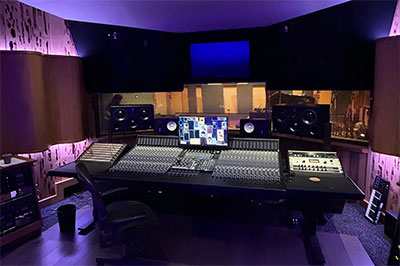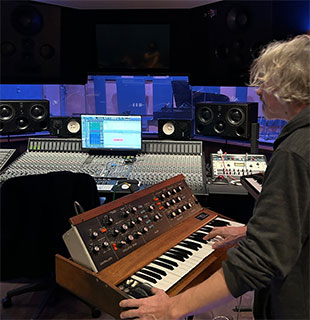Having originally opened in 1972 as the Record Plant Sausalito, later operating as The Plant and then Plant Studios, 2200 Studios in San Francisco’s Bay Area recently relaunched following a comprehensive modernisation after lying vacant for a period. Now, the facility has a new flagship room in the shape of its refurbished Studio A, which features a 32-channel Solid State Logic Origin analogue in-line mixing console.
 Change is a constant at the complex – especially for Studio A, which has previously been home to consoles from a variety of manufacturers. ‘About every ten years this room got remodelled,’ confirms Damien Lewis, the facility’s Director of Operations and Chief Engineer.
Change is a constant at the complex – especially for Studio A, which has previously been home to consoles from a variety of manufacturers. ‘About every ten years this room got remodelled,’ confirms Damien Lewis, the facility’s Director of Operations and Chief Engineer.
For Lewis, there was only one console manufacturer to consider for this latest revision: ‘The Origin made a lot of sense to me because it incorporates the best of SSL up to this point,’ he says. ‘We make records differently now, and the Origin has the modern features that we require for today’s music, down to the 0dB summing mixer mode. It sounds amazing and it reflects the modern hybrid workflow with a footprint and low power consumption – I love the auto sleep mode – offers a lot of bang for the buck.’
The studio purchased the new Origin as a turnkey package, including wiring looms and patchbays, from Sweetwater and sales tech Michael Grebe. ‘He flew out and worked with our tech to do the install,’ Lewis says. ‘The process was seamless, and we had it up and running in about two days.’
The facility was built in Marin County, just north across the Golden Gate Bridge from San Francisco, as the last of Record Plant’s three locations, after New York City and Los Angeles. The redwood-clad building where Stevie Wonder, Fleetwood Mac and Sly Stone recorded a number of classic albums came under new ownership about four years ago. Under Lewis’ guidance, the facility is now being restored to full operation with all-new technology and renovated interiors.
Lewis has a 500 Series rack installed in Origin’s centre section, but ‘drops in’ a UF8 controller if additional faders are needed for automation duties. ‘I love the modularity, and I love that someone was smart enough to move the EQ section down so you can reach it without having to stand up and reach over the aux sends. And the routing matrix being located in the centre section is also fantastic,’ he says of the bus assignment controls in the master tile of the console.
 A couple of Grammy-winning engineers and producers have worked in the new room since it opened. ‘They were cutting bands and used all SSL mic preamps, right off the bat,’ he reports. ‘We have a rack full of other mic preamps, but they both went straight to the SSL preamps and got amazing sounds in five minutes. So we’ve been nothing but thrilled by our new Origin.’
A couple of Grammy-winning engineers and producers have worked in the new room since it opened. ‘They were cutting bands and used all SSL mic preamps, right off the bat,’ he reports. ‘We have a rack full of other mic preamps, but they both went straight to the SSL preamps and got amazing sounds in five minutes. So we’ve been nothing but thrilled by our new Origin.’
Lewis involves Origin in every project: ‘Even in cases where I use external processing, I bring everything back at line level on a fader before Pro Tools. I love how the console’s default state is small fader to tape. The workflow makes a lot of sense; the way you can punch the filters and EQ in and out, the dual input paths per channel, and the path flip. Everything hits the small fader, then I like to use the EQs on the console – that’s my workflow. No matter what the signal path is, it always ends up coming through the SSL before it goes to tape or Pro Tools.’
The Origin also appears a perfect fit for the modern pop world’s workflow: When I’m working with a lot of pop producers, they’re bringing in a workstation, keyboard synths and interfaces, and I’ll have those running through the console and feeding Pro Tools. If I’m working with a guy like Danja, who produces all the Justin Timberlake stuff, he’ll be building a beat in Ableton and sending me stems that I’ll put into Pro Tools. He’ll also start playing stuff live, so I’ll have his interface running through a set of faders that are bused to Pro Tools inputs. I’m simultaneously monitoring live inputs and feeding inputs into Pro Tools and recording. I keep Channels 1 & 2 in the 0dB fader bypass mode, pan the channels left and right and I have a perfect Pro Tools monitor path, right off the console. That workflow, for me, is crucial.’
Recently, Lewis began getting creative with Origin’s Listen Mic Compressor (LMC). ‘We’ll throw a mic over a lighting truss and patch that to the LMC. That’s been great for communication, and it’s also super cool to record some huge drums. The eighth-inch [3.5mm] input for aux stuff is very handy because that’s the world we live in. In fact, we’re using darn near every single part of this Origin.
‘I’m an SSL guy,’ Lewis asserts. ‘I’ve always loved them, and the SSL workflow.’
More: www.solidstatelogic.com













